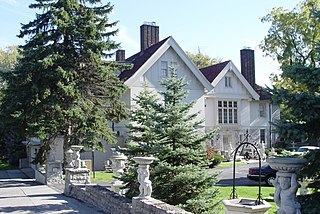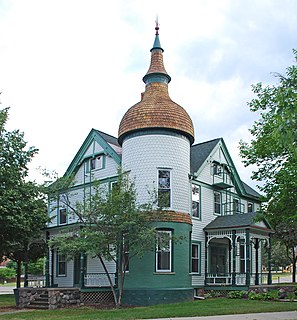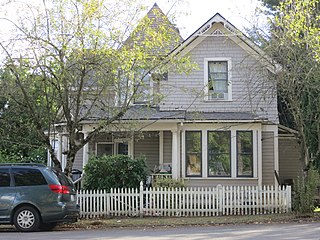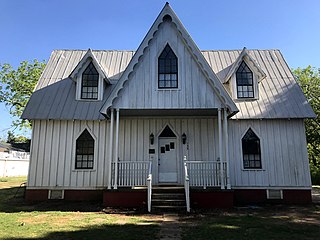
The Clark–Northrup House is a historic house in Sherborn, Massachusetts. Built c. 1845–55, it is a locally unusual example of a Greek Revival house with a more traditional Georgian side-gable roof. The house was listed on the National Register of Historic Places in 1986.

The Edisen Fishery is a fishery located in Rock Harbor in the Isle Royale National Park in Michigan. It was designated a Michigan State Historic Site in 1976 and listed on the National Register of Historic Places in 1977.

Bassickville Historic District is a historic district encompassing a well-preserved late 19th-century residential development on the west side of Bridgeport, Connecticut. Located on Bassick, Howard, and Fairview Avenues, the area was developed as a residential subdivision of worker housing by Edmund Bassick. The development is characterized by nearly identical 1-1/2 story frame cottages exhibiting the Stick style of architecture. The district was listed on the National Register of Historic Places in 1987.

The Unity Ranger Station is a United States Forest Service compound consisting of five buildings and a lookout tower in the Wallowa-Whitman National Forest of northeastern Oregon. It was previously the administrative headquarters for the Unity Ranger District. It is located in the small unincorporated community of Unity, Oregon. The historic structures were built in the rustic style by the Civilian Conservation Corps between 1936 and 1938. Today, the ranger station is only used during the summer months to house Forest Service fire crews. The ranger station is listed on the National Register of Historic Places.

The John Thompson Woodhouse House is a private house located at 33 Old Brook Ln. in Grosse Pointe Farms, Michigan. It was listed on the National Register of Historic Places in 2005.

The Brinkerhoff–Becker House, also known as the Becker–Stachlewitz House, was built as a private home, and is located at 601 West Forest Avenue Ypsilanti, Michigan. It was designated a Michigan State Historic Site in 1977 and listed on the National Register of Historic Places in 1982.

The John E. Booth House is a historic house located in Provo, Utah. John E. Booth was a significant Provoan, and was extensively involved in Provo's community and religious affairs. Located at 59 West and 500 North and less than one acre in size, the John E. Booth House was built in 1900, and happens to be the only 2+1⁄2-story Victorian Mansion in Provo, Utah. This house is significant not only as a Victorian mansion, but because its "Bricks were individually painted to create a variegrated design effect". The house was added to the National Register of Historic Places in 1982. The house was designated to the Provo City Historic Landmark Register on May 26, 1995.

The John Roffler House is a historic house located at 1437 NE Everett Street in Camas, Washington.

The Ironwood City Hall was a government building located at the corner of McLeod Avenue and Norfolk Street in Ironwood, Michigan. It was listed on the National Register of Historic Places in 1980, designated a Michigan State Historic Site in 1975, and demolished in 1989.

The Iron County MRA is a Multiple Resource Area addition to the National Register of Historic Places, which includes 72 separate structures and historic districts within Iron County, Michigan, United States of America. These properties were identified and placed on the Register in 1983, with the exception of one property that was placed on the Register in 1993.

The Frank J. Cobbs House is a private house located at 407 E. Chapin Street in Cadillac, Michigan. It was designated a Michigan State Historic Site in 1985 and listed on the National Register of Historic Places in 1988.

Ivey-Ellington House is a historic home located at Cary, Wake County, North Carolina. The house was built about 1870 in the gothic cottage stye. It is a 1+1⁄2-story, "T"-plan, frame I-house with board-and-batten siding. It has a steeply pitched roof, decorative scalloped gable trim, and pointed-arch windows.

The Guilford Country Store is located at 475 Coolidge Highway in Guilford, Vermont, in the 1817 Broad Brook House, one of the oldest surviving tavern houses in the state, which has been in continuous use as a general store since 1936. The building was listed on the National Register of Historic Places in 2011.

The East Chicago Street Historic District is a mixed residential and commercial historic district located in Coldwater, Michigan. The original portion of the district, running along Chicago Street from Wright Street to Division Street, was listed on the National Register of Historic Places in 1975. Two boundary increases were added in 1990, one running roughly along Pearl Street between Hudson and Lincoln Streets, and the other roughly along Church Street from Jefferson to Daugherty Streets, along with the block of Park Place north of Church and the block of Hull Street west of Park Place.

The Thomas W. and Margaret Taliaferro House is a single-family home located at 1115 Eton Cross in Bloomfield Hills, Michigan. It was listed on the National Register of Historic Places in 2011.

The Bell-Spalding House, also known as the Tuomy House, is a single-family home located at 2117 Washtenaw Avenue in Ann Arbor, Michigan. It was listed on the National Register of Historic Places in 1990.

The Langford and Lydia McMichael Sutherland Farmstead is a farm located at 797 Textile Road in Pittsfield Charter Township, Michigan. It was listed on the National Register of Historic Places in 2006. It is now the Sutherland-Wilson Farm Historic Site.

The John N. Ingersoll House is a single-family home located at 570 West Corunna Avenue in Corunna, Michigan. It was listed on the National Register of Historic Places in 1980.

The Gordon Hitt Farmstead is a former farm located at 4561 North Lake Road near Clark Lake, Michigan. It was listed on the National Register of Historic Places in 1994. It now serves as a vacation rental.
The Frederick A., Jr. and Caroline Hewett Kennedy Farm is a historic farmstead located at 8490 Hanover Road near Hanover, Michigan. It was listed on the National Register of Historic Places in 2000.





















